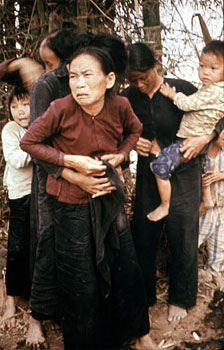| what happens in war — and the major who tried to cover it up
The Massacre at Mylai

With bodies and burning huts all around them troops had accosted the young 13-year-old girl seen here trying to button her top. Another woman tries to hold back the girl's distraught mother. When the troops noticed Haeberle, the photographer, they stopped and turned away as if everything was normal.
"Then a soldier asked, 'Well, what'll we do with 'em?'"
"Kill 'em," another answered."
"I heard an M60 go off," says Roberts, "a light machine gun, and when we turned back around, all of them and the kids with them were dead."
[more]
colin powell: don't ask about my lai, don't tell about iran-contra
The My Lai massacre. On March 16, 1968, US soldiers from the Americal Division slaughtered 347 civilians--primarily old men, women, children, and babies--in the Vietnamese village of My Lai 4 (pronounced, very appropriately, as "me lie"). The grunts also engaged in torture and rape of the villagers.
Around six months later, a soldier in the 11th Light Infantry Brigade--known among the men as "the Butcher's Brigade"--wrote a letter telling of widespread killing and torturing of Vietnamese civilians by entire units of the US military (he did not specifically refer to My Lai). The letter was sent to the general in charge of 'Nam and trickled down the chain of command to Major Colin Powell, a deputy assistant chief of staff at the Americal Division, who was charged with investigating the matter and formulating a response.
After a desultory check--which consisted mainly of investigating the soldier who wrote the letter, rather than his allegations--Powell reported that everything was hunkey-dory. There may be some "isolated incidents" by individual bad seeds, but there were no widespread atrocities. He wrote: "In direct refutation of this portrayal is the fact that relations between Americal soldiers and the Vietnamese people are excellent." The matter was closed.
[more]
|

